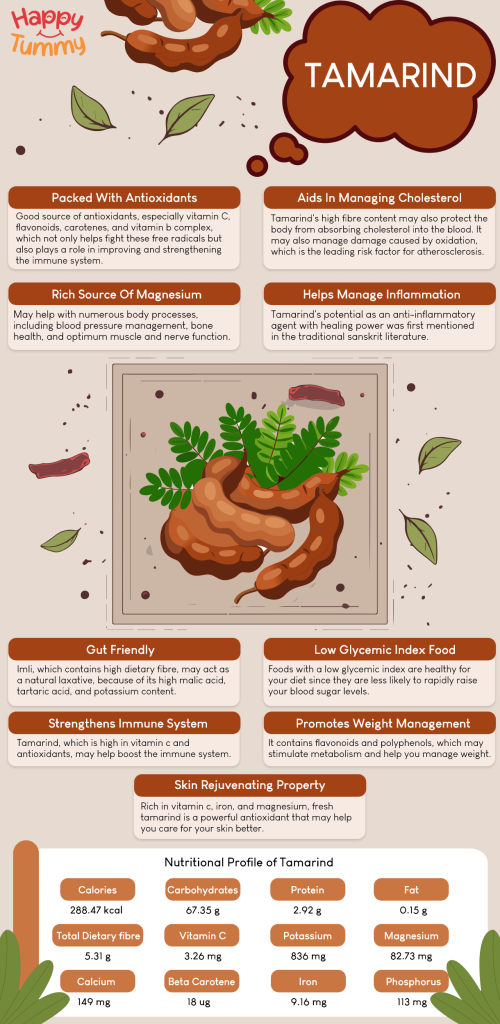Table of Contents
We always feel guilty about sacrificing our health in the never-ending desire to eat delicious food.
But what if we tell you that you may not have to compromise on health on your journey to enjoying delicious flavors? Yes, it is the Imli we are talking about—the word Imli is mouthwatering!
Packed with essential nutrients, Imli supports overall well-being and helps the body stay nourished while delighting your taste buds.
The fruit tamarind, which has a distinct flavour, is one such delicacy.
It enhances the flavour of any meal, whether used as a spice or as a tangy-sweet condiment in Indian cuisine, particularly in mouthwatering chaat dishes.
It also doubles in taste when used as a chutney. This article provides all the information about tamarind’s health benefits, uses, and nutrient content.
What is Tamarind?
Tamarind is a hardwood tree known scientifically as Tamarindus Indica. Although native to Africa, it may also grow in many tropical places, including India and Pakistan.
The tree yields bean-like pods with fibrous pulp encasing seeds. The young fruit has a sour, green pulp. The luscious pulp gets more sweet-sour and paste-like as it ripens.
Interestingly, tamarind is frequently called the “date of India.”
There are several names for this sweet-sour treat in India:
| Language | Name for Tamarind |
| Hindi | Imli |
| Marathi | Chinch |
| Gujarati | Ambli |
| Bengali | Tetul |
| Tamil | Puli |
| Telugu | Chintapandu |
| Kannada | Hunasehannu |
| Oriya | Tentuli |
| Assamese | Teteli |
| Konkani | Chinch |
| Kashmiri | Ambli |
Tamarind (Imli) Nutritional Value
Tamarind is not just a flavorful fruit but also packed with essential nutrients. Here’s a breakdown of its nutritional profile per 100 grams of tamarind pulp: [1]
| Nutrient | Amount | Health Benefit |
| Calories | 288.47 kcal | Provides energy |
| Carbohydrates | 67.35 g | Excellent source of quick energy |
| Protein | 2.92 g | Promotes muscular development and tissue regeneration |
| Fat | 0.15 g | Minimal fat content, suitable for diets low in fat |
| Dietary Fiber | 5.31 g | Helps with digestion and keeps constipation at bay. |
| Vitamin C | 3.26 mg | Works as an antioxidant and strengthens immunity. |
| Potassium | 836 mg | Keeps electrolyte balance and heart health intact. |
| Magnesium | 82.73 mg | Helps maintain healthy bones and muscles. |
| Calcium | 149 mg | Makes teeth and bones stronger. |
| Iron | 9.16 mg | Helps carry oxygen and keeps anaemia at bay |
| Phosphorus | 113 mg | Vital for the generation of energy and healthy bones |
| Beta Carotene[2] | 18 ug | A precursor to vitamin A may promote immune function |
Additionally, it includes polyphenols, which are health-promoting naturally occurring plant components. The body uses several of them as antioxidants.
Therefore, it is a rich source of the majority of phytochemicals and necessary amino acids.[3]
Tamarind Health Benefits

The tamarind fruit has a fibrous, nutrient-rich pulp.
Among other advantages, its nutrients may have antiviral, antifungal, antibacterial, and antioxidant properties.
1. Packed with Antioxidants
Some foods include naturally occurring compounds called antioxidants. They support your body’s defences against cellular damage caused by free radicals.
Free radicals are unstable chemicals that can induce oxidative stress and result in illness and other health problems, causing autoimmune conditions, inflammation, cardiovascular diseases, and neurodegenerative conditions, such as Parkinson’s and Alzheimer’s.
Tamarinds are a good source of antioxidants, especially vitamin C, flavonoids, carotenes, and vitamin B complex, which not only helps fight these free radicals but also plays a role in improving and strengthening the immune system.
The tamarind pulp is also rich in numerous phytonutrients that serve as potent dietary antioxidants. It is particularly rich in beta-carotene, an antioxidant that may promote eye health.[4]
2. Rich Source of Magnesium
Tamarind is regarded as a high magnesium source. This mineral may help with numerous body processes, including blood pressure management, bone health, and optimum muscle and nerve function.
Consequently, eating it may help you meet your magnesium requirements and perhaps offer these related advantages.[5]
3. Helps Manage Inflammation
Inflammation is a typical body response that corresponds to several hazards, such as chronic illnesses, physical trauma, sickness, and damage in the body.
It is the body’s way of neutralizing or eliminating harmful invaders and clearing out harmful agents.
Though an inflammation reaction plays a vital role in biological defense mechanisms in the early stages, chronic inflammation has long been linked to various non-infectious diseases.
Tamarind’s potential as an anti-inflammatory agent with healing power was first mentioned in the traditional Sanskrit literature. [6]
Studies have reported that Luteolin, a flavonoid in tamarind, has anti-inflammatory properties. Tannins are another set of active compounds in it with potent anti-inflammatory properties.
The essential oil of tamarind has also been connected to several anti-inflammatory properties, including managing joint pain and inflammation, arthritis, rheumatic conditions, and gout. [7]
4. Low Glycemic Index Food
If you have diabetes, you are likely already familiar with the glycemic index. Foods that contain carbohydrates are categorised according to their propensity to elevate blood sugar levels.
Foods with a low glycemic index are healthy for your diet since they are less likely to rapidly raise your blood sugar levels. If you have diabetes, this is crucial, and tamarind can be one of those things.
Although tamarind has a reasonably high sugar content (52.88 grams per 100 grams), it has a low glycaemic index, meaning it may not raise blood sugar levels. [1] [8]
5. Gut Friendly
Tamarind might be your go-to natural remedy for stomach problems. To activate digestive fluids and promote healthy digestion, chew on the pulp of this tart-sweet fruit.[9]
Imli, which contains high dietary fibre, may act as a natural laxative, because of its high malic acid, tartaric acid, and potassium content.
It contains natural digestive enzymes, including amylase and lipase, which help break down food and improve digestion.
You could occasionally experience confusion over your digestive quotient. With Aashirvaad Digestive Quotient, however, things become more manageable.
The Digestion Quotient test, created by Aashirvaad Atta with Multigrains and a team of professional nutritionists, determines your digestion score on a scale of 100.
6. Aids in Managing Cholesterol
The abundant flavonoid content in Imli is said to have an immense positive effect on cardiovascular health and hence may help to manage blood triglycerides, LDL, or bad cholesterol levels.
High triglyceride and LDL levels indicate poor health because they can clog arteries, limiting blood flow and impairing the heart’s ability to perform at its best.[10]
Tamarind’s high fibre content may also protect the body from absorbing cholesterol into the blood. It may also manage damage caused by oxidation, which is the leading risk factor for atherosclerosis.
It increases cholesterol excretion, decreases cholesterol biosynthesis, increases LDL-cholesterol intake from peripheral tissues, and prevents triglyceride accumulation in the liver.
7. Strengthens Immune System
Increasing antibiotic resistance among bacteria causes the seeking of new effective agents. Tamarind, which is high in vitamin C and antioxidants, may help boost the immune system.
This sour fruit might also prevent the spread of microbial and fungal illnesses.[11]
Furthermore, consuming tamarind daily might benefit individuals who suffer from allergies. Its antibacterial characteristics may assist the body in recovering from infections, asthma, colds, and coughs.
8. Promotes Weight Management
Tamarind is a low-fat, fibre-rich meal that is ideal for weight management. It contains flavonoids and polyphenols, which may stimulate metabolism and help you manage weight.
The fibre content may increase fullness, lower cravings for harmful foods, and bulk the stool.
Flavonoids and polyphenols may reduce appetite and promote weight management. This fruit has a metabolic effect on fat and may reduce fat absorption.[12] Being fibre-rich might keep you fuller for longer.
Sometimes, you may find it difficult to plan healthy meals and always look for strategies to increase your fibre intake. But wonder who to counsel and how to approach it.
Well, fear not, folks—Aashirvaad Atta with Multigrains and a team of trained nutritionists have created the My Meal Plan test, which may determine your daily fibre intake and provide you with a comprehensive meal plan that complies with recommended intake.
9. Skin Rejuvenating Property
Rich in vitamin C, iron, and magnesium, fresh tamarind is a powerful antioxidant that may help you care for your skin better. Drinking Imli juice might help detoxify and cleanse your skin.
In addition to promoting collagen synthesis, the vitamin C in tamarind may combat dangerous free radicals, delaying ageing and enhancing skin suppleness. [13]
Side Effects Of Tamarind
Tamarind is typically safe to consume unless you have specific medical issues.
Allergy: If you are allergic to this fruit, do, consult your doctor before adding tamarind to your diet.
Digestive Issues: Excessive consumption of Imli can act as a laxative, causing stomach pain or dehydration in extreme cases of diarrhoea.
Dental Health: Because tamarind is acidic, eating it can damage your teeth by dissolving the enamel.
Different Forms of Tamarind
Tamarind comes in various forms, including frozen, chilled, and shelf-stable varieties. Here’s what you’ll discover and how to use it.
Tamarind in Pods Form
The stage at which they were picked determines the classification of whole tamarind pods. Green, unripe tamarind, often sour, has the highest acidity and tartness.
Ripe Imli is brown and delightfully tart. You may eat sweet tamarind right out of the pod. Dried tamarind pulp is sold in bricks that contain the membrane and seeds from Imli pods.
Tamarind in Paste Form
Imli paste is easy to include in recipes since it is seedless and formed from Imli flesh diluted with water. Tamarind, water, and occasionally a preservative are the sole ingredients of high-quality pastes.
Tamarind in Concentrate Form
Imli concentrates are thick and dark and have a molasses-like consistency. You can dilute concentrates with water to make them taste like tamarind water.
Tamarind in Frozen Form
You may also use frozen unsweetened tamarind, although it may not be as strong, so you might need to add more to taste. This version is thinner and has a milder flavour than others; just defrost and use as required.
Tamarind in Powder Form
Last but not least is tamarind powder, which is formed by grinding and dehydrating tamarind. It can be used to flavour sweets, beverages, and sauces.
The Bottom Line
Imli, known as tamarind, is a common ingredient in Southeast Asian and Indian cooking. It is used to make soups, curries, sweets, and sauces.
Rich in antioxidant vitamins and minerals, this tart-sweet fruit might help with digestive problems. It may protect the body from harmful free radicals and act as a natural laxative.
So, these health perks add to the answer to the question, “Is tamarind nutritious?” Although it might be a fantastic addition to your diet, don’t forget to savour it as part of a balanced meal plan.
It’s always a good idea to speak with professionals for individualised advice on a healthy lifestyle! Our certified nutritionist would be pleased to assist you. Use the link to schedule your consultation with us.
Frequently Asked Questions
The tamarind is a multipurpose component. You can use it in chutneys, sauces, soups, and marinades. It’s also an essential ingredient in recipes like rasam rice and sambar.
After thoroughly immersing the Imli in the boiling water, cover it with plastic wrap and leave it for 30 to 45 minutes. Initially, use a fork to stir the tamarind frequently Later, when the water cools, rub the fruit between your fingers to extract the seeds. The mixture will become pulpy and thick. .
People with Imli allergies, acid reflux, or other digestive problems, and those using blood thinners or are on any medications, kindly consult a healthcare professional to understand what best suits them.
Rich in potassium, magnesium, calcium, and other minerals, tamarind seeds may help manage electrolyte balance and cholesterol. Hence, it is safe to eat roasted tamarind seeds as a snack.
Indeed, tamarind water offers several health advantages and is safe to use. It may aid constipation and digestion and is a delicious way to remain hydrated. Tamarind water may aid with managing your weight by boosting your metabolism.















